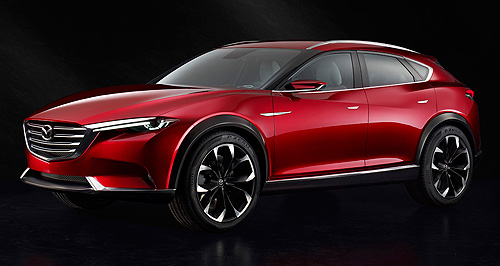Future models - Mazda - CX-6Mazda mulls CX-6 coupe crossoverCrystal ball: The design of the so-called CX-6 is believed to be inspired by the 2015 Mazda Koeru concept. Out early next decade, Mazda’s US-made SUV would slot between CX-5 and CX-8/CX-925 Sep 2018 MAZDA is understood to be in the advanced planning stages for a so-called ‘CX-6’, a coupe-like five-seat SUV in the mould of the BMW X6 that would slot into its growing SUV line-up between the top-selling CX-5 and the seven-seat CX-9 early next decade.
Expected to launch in about 2021, the new model line is believed to be derived from the next-generation CX-5 platform, down to the SkyActiv chassis and powertrains, but it is unlikely to share any body or interior panels, instead carrying a sportier and more premium look.
While flatly refusing to comment on any future product including the mooted CX-6, Mazda Australia marketing director Alastair Doak has told GoAuto that any addition to the company’s SUV line-up “would be warmly welcomed in Australia, due to the growing popularity of SUVs”.
Aimed primarily at the North American market where it would also be built for global consumption at a new joint-facility plant with Toyota in Alabama, the newcomer’s styling is believed to have been previewed to a large extent by the Koeru concept, first seen at the 2015 Frankfurt motor show.
While the production version’s design would undoubtedly have progressed in the intervening three years, the show car’s swoopy silhouette, four-square proportions and clean detailing are likely hints to what can be expected.
The CX-6 is likely to carry a higher pricetag than the CX-5 and will probably include the 2.5-litre four-cylinder turbocharged petrol engine from the larger CX-9 and Mazda6, as well as the rumoured performance version of the CX-5 that is expected to surface soon.
Look, too, for a rollout of Mazda’s new SkyActiv-X petrol engines that use compression ignition in which the fuel-air mixture ignites when compressed by the piston, similar to a diesel engine.
In an interview with Automotive News late last year, former Mazda Motor Corporation (MMC) president and CEO Masamichi Kogai revealed the company’s plans to boost US sales with an all-new crossover line-up that would be tailored specifically for American tastes from 2021.
“We are going to introduce a totally new and different type of SUV,” he said at the time. “R&D is co-ordinating with our North American operations on that right now.”
Whether that refers to the CX-6 or a larger 5+2-seater SUV that could slip beneath the CX-9 as a reborn CX-7 remains to be seen.
Now MMC chairman, Mr Kogai stepped down after five years in the role in June, replaced by vice-president and operations boss for the Americas, Akira Marumoto, to help boost Mazda’s disappointing market share in North America.
When Mazda and Toyota revealed their new joint-venture company, Mazda Toyota Manufacturing USA Inc in May, the statement included plans for 150,000 units of a Mazda crossover as well as 150,000 Toyota Corollas to be built in Alabama annually.
If Mazda opts for the CX-6 moniker, it would be the third even-numbered SUV after the Chinese-market CX-4 and CX-8 seven-seat diesel SUV in the car-maker’s global range.
While the Mazda3-based CX-4 produced solely for the Chinese market is a non-starter for Australia, it is likely that the next-generation version also due about 2021 might make it Down Under, as Mazda is keen to ultimately extend its SUV offerings.
The CX-7 nameplate, of course, has been used in the past, specifically for a US Ford Edge-based five-seat SUV sized and packaged for Americans and sold in Australia from 2006 until the arrival of the CX-5 in 2012, a model which has gone on to dominated the high-volume mid-size SUV segment.
Larger than the Mazda Tribute it replaced, and initially powered by a 2.3-litre four-cylinder direct-injection turbo-petrol engine shared with the contemporary Mazda6 MPS, the original CX-7 suffered from being too large for many compact SUV buyers, high pricing and poor fuel economy in an era when oil prices soared.
The Series II facelift of 2009 attempted to address these issues with a cheaper normally aspirated 2.5-litre petrol version as well as a 2.2-litre turbo-diesel option, but by then it was too little and too late for the series.
The upshot of this is that Mazda may be hesitant to exhume the badge for its future SUV.  Read moreAll future models Alfa Romeo Alfa Romeo Abarth Abarth Audi Audi Aston Martin Aston Martin BMW BMW Bentley Bentley Chrysler Chrysler Chevrolet Chevrolet Dodge Dodge Citroen Citroen Ferrari Ferrari DS DS Ford Ford Fiat Fiat FPV FPV Foton Foton Haval Haval Great Wall Great Wall Honda Honda Holden Holden Hyundai Hyundai HSV HSV Isuzu Isuzu Infiniti Infiniti Jeep Jeep Jaguar Jaguar Lamborghini Lamborghini Kia Kia Lexus Lexus Land Rover Land Rover Mazda Mazda Maserati Maserati Mercedes-Benz Mercedes-Benz McLaren McLaren Mini Mini Nissan Nissan Mitsubishi Mitsubishi Peugeot Peugeot Opel Opel Proton Proton Porsche Porsche Renault Renault Ram Ram Saab Saab Rolls-Royce Rolls-Royce Smart Smart Skoda Skoda Subaru Subaru SsangYong SsangYong Tesla Tesla Suzuki Suzuki Toyota Toyota Volvo VolvoMotor industry news |
Click to shareMazda modelsResearch Mazda All future models Alfa Romeo Alfa Romeo Abarth Abarth Audi Audi Aston Martin Aston Martin BMW BMW Bentley Bentley Chrysler Chrysler Chevrolet Chevrolet Dodge Dodge Citroen Citroen Ferrari Ferrari DS DS Ford Ford Fiat Fiat FPV FPV Foton Foton Haval Haval Great Wall Great Wall Honda Honda Holden Holden Hyundai Hyundai HSV HSV Isuzu Isuzu Infiniti Infiniti Jeep Jeep Jaguar Jaguar Lamborghini Lamborghini Kia Kia Lexus Lexus Land Rover Land Rover Mazda Mazda Maserati Maserati Mercedes-Benz Mercedes-Benz McLaren McLaren Mini Mini Nissan Nissan Mitsubishi Mitsubishi Peugeot Peugeot Opel Opel Proton Proton Porsche Porsche Renault Renault Ram Ram Saab Saab Rolls-Royce Rolls-Royce Smart Smart Skoda Skoda Subaru Subaru SsangYong SsangYong Tesla Tesla Suzuki Suzuki Toyota Toyota Volvo VolvoMotor industry news |
















Facebook Twitter Instagram